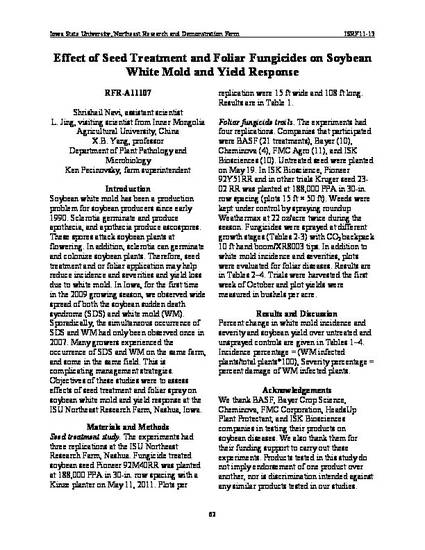
Article
Effect of Seed Treatment and Foliar Fungicides on Soybean White Mold and Yield Response
Iowa State Research Farm Progress Reports
Farm
Northeast Research and Demonstration Farm
Extension Number
RFR A11107
Publication Date
1-1-2012
Disciplines
Abstract
Soybean white mold has been a production problem for soybean producers since early 1990. Sclerotia germinate and produce apothecia, and apothecia produce ascospores. These spores attack soybean plants at flowering. In addition, sclerotia can germinate and colonize soybean plants. Therefore, seed treatment and or foliar application may help reduce incidence and severities and yield loss due to white mold. In Iowa, for the first time in the 2009 growing season, we observed wide spread of both the soybean sudden death syndrome (SDS) and white mold (WM). Sporadically, the simultaneous occurrence of SDS and WM had only been observed once in 2007. Many growers experienced the occurrence of SDS and WM on the same farm, and some in the same field. This is complicating management strategies. Objectives of these studies were to assess effects of seed treatment and foliar spray on soybean white mold and yield response at the ISU Northeast Research Farm, Nashua, Iowa.
Copyright Owner
Iowa State University
Copyright Date
2012
Language
en
File Format
application/pdf
Citation Information
Shrishail S. Navi, L. Jing, Xiao-Bing Yang and Kenneth T. Pecinovsky. "Effect of Seed Treatment and Foliar Fungicides on Soybean White Mold and Yield Response" (2012) Available at: http://works.bepress.com/shrishail_navi/2/
